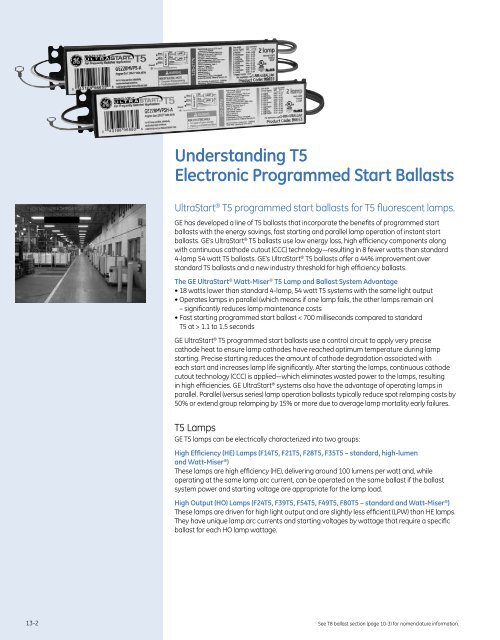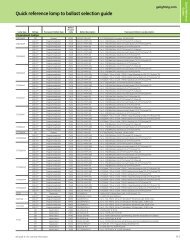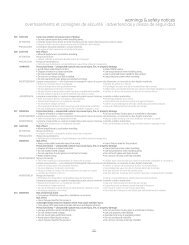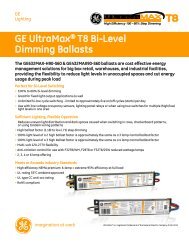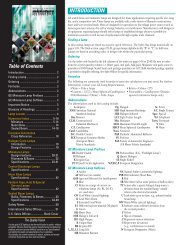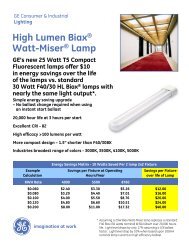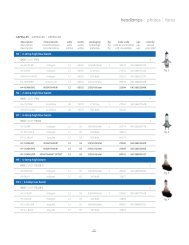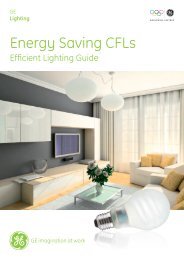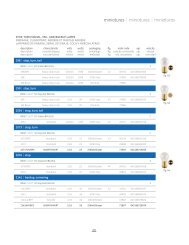Ballasts: T5 Electronic Programmed Start - GE Lighting Asia Pacific
Ballasts: T5 Electronic Programmed Start - GE Lighting Asia Pacific
Ballasts: T5 Electronic Programmed Start - GE Lighting Asia Pacific
Create successful ePaper yourself
Turn your PDF publications into a flip-book with our unique Google optimized e-Paper software.
Understanding <strong>T5</strong><br />
<strong>Electronic</strong> <strong>Programmed</strong> <strong>Start</strong> <strong>Ballasts</strong><br />
Ultra<strong>Start</strong> ® <strong>T5</strong> programmed start ballasts for <strong>T5</strong> fluorescent lamps.<br />
<strong>GE</strong> has developed a line of <strong>T5</strong> ballasts that incorporate the benefits of programmed start<br />
ballasts with the energy savings, fast starting and parallel lamp operation of instant start<br />
ballasts. <strong>GE</strong>’s Ultra<strong>Start</strong> ® <strong>T5</strong> ballasts use low energy loss, high efficiency components along<br />
with continuous cathode cutout (CCC) technology—resulting in 8 fewer watts than standard<br />
4-lamp 54 watt <strong>T5</strong> ballasts. <strong>GE</strong>’s Ultra<strong>Start</strong> ® <strong>T5</strong> ballasts offer a 44% improvement over<br />
standard <strong>T5</strong> ballasts and a new industry threshold for high efficiency ballasts.<br />
The <strong>GE</strong> Ultra<strong>Start</strong> ® Watt-Miser ® <strong>T5</strong> Lamp and Ballast System Advantage<br />
• 18 watts lower than standard 4-lamp, 54 watt <strong>T5</strong> systems with the same light output<br />
• Operates lamps in parallel (which means if one lamp fails, the other lamps remain on)<br />
– significantly reduces lamp maintenance costs<br />
• Fast starting programmed start ballast < 700 milliseconds compared to standard<br />
<strong>T5</strong> at > 1.1 to 1.5 seconds<br />
<strong>GE</strong> Ultra<strong>Start</strong> ® <strong>T5</strong> programmed start ballasts use a control circuit to apply very precise<br />
cathode heat to ensure lamp cathodes have reached optimum temperature during lamp<br />
starting. Precise starting reduces the amount of cathode degradation associated with<br />
each start and increases lamp life significantly. After starting the lamps, continuous cathode<br />
cutout technology (CCC) is applied—which eliminates wasted power to the lamps, resulting<br />
in high efficiencies. <strong>GE</strong> Ultra<strong>Start</strong> ® systems also have the advantage of operating lamps in<br />
parallel. Parallel (versus series) lamp operation ballasts typically reduce spot relamping costs by<br />
50% or extend group relamping by 15% or more due to average lamp mortality early failures.<br />
<strong>T5</strong> Lamps<br />
<strong>GE</strong> <strong>T5</strong> lamps can be electrically characterized into two groups:<br />
High Efficiency (HE) Lamps (F14<strong>T5</strong>, F21<strong>T5</strong>, F28<strong>T5</strong>, F35<strong>T5</strong> – standard, high-lumen<br />
and Watt-Miser ® )<br />
These lamps are high efficiency (HE), delivering around 100 lumens per watt and, while<br />
operating at the same lamp arc current, can be operated on the same ballast if the ballast<br />
system power and starting voltage are appropriate for the lamp load.<br />
High Output (HO) Lamps (F24<strong>T5</strong>, F39<strong>T5</strong>, F54<strong>T5</strong>, F49<strong>T5</strong>, F80<strong>T5</strong> – standard and Watt-Miser ® )<br />
These lamps are driven for high light output and are slightly less efficient (LPW) than HE lamps.<br />
They have unique lamp arc currents and starting voltages by wattage that require a specific<br />
ballast for each HO lamp wattage.<br />
13-2 See T8 ballast section (page 10-3) for nomenclature information.


